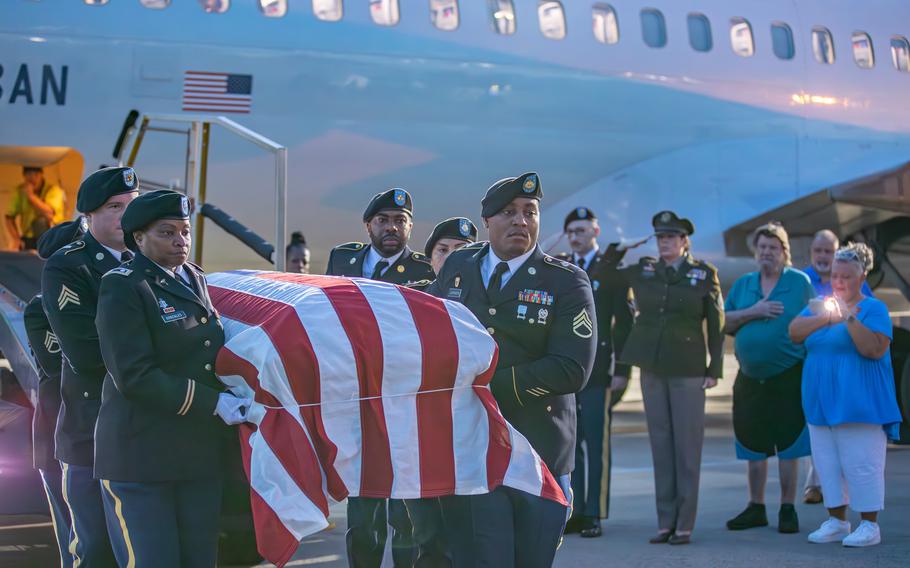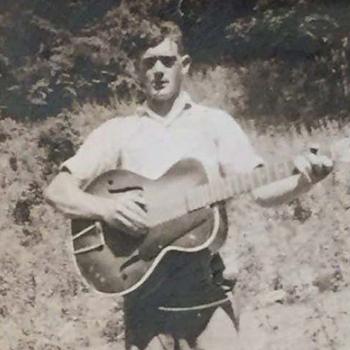
The Military Honors Team stationed at Fort Liberty, N.C., carry the flag-draped casket containing the remains of U.S. Army Pfc. Mose E. Vance at Charlotte International Airport in Charlotte, N.C., on July 31, 2024. Vance was killed in action in France in January 1945 during World War II. The Vance family worked with the Defense POW/MIA Accounting Agency to identify Vance’s remains after being interred, unidentified, in France, for nearly 80 years. (Ariana Shuemake/U.S. Army National Guard)
U.S. Army Pfc. Mose E. Vance of Bradshaw, W.Va., returned home last week decades after he was killed during World War II. Vance was 21 at the time of his death in 1945.
Vance’s remains were released to his closest living relative Wednesday in Charlotte, N.C.
For the past several decades, Vance had been interred at the U.S. Military Cemetery at St. Avold, France, known today as Lorraine American Cemetery. Following his return to the United States, his final resting place will be at the Vance Cemetery in Paynesville, W.Va. Services will be held Aug. 10, 2024.
The homecoming marks the end of a journey not just for Vance but also for his family.
Following the identification and accountability of Vance’s remains on Jan. 5, 2024, his return home is one of the last chapters in the years-long journey for the Vance family.
Oakley Ferrell Vance, or “Ferrell” as he calls himself, Vance’s closest living relative, recalls starting the project with his brother.
“Well, about five or six years ago, me and my brother actually started talking about the whole family, how we used to hear her grandmother (Ferrell’s great-grandmother) and my grandmother talking about Uncle Mose,” Ferrell said. “And she never would accept that he got killed in service. She always thought that he was missing and would someday be found, or had amnesia. She just never would accept it, and I guess getting older and my brother and I started talking about it. I said ‘let’s try to find him.’ ”
Throughout the next several years, Ferrell, as a means to fill his time after retirement, “kept digging,” which led him to get in touch with a volunteer organization in France that was sponsoring Vance. “I got in contact with him and after a couple years of searching ... they gave me a lot of information … they traced it to where they had his remains and they did some DNA testing and got a positive hit,” Ferrell recalled.
Once Vance was positively identified based on the DNA analysis results on Jan. 5, 2024, Jim Bell, a U.S. Army Identification Specialist working for the Defense POW/MIA Accounting Agency (DPAA), stepped in.
“I notify the family of the identification. I get a Casualty Assistance Officer (CAO) assigned and then I brief the family on the loss/recovery of the Soldier and how the Soldier was identified,” Bell stated.
Green also got to let the family know about medals that would be conferred.
“I had the honor of presenting the Purple Heart and the Bronze Star medals to Ferrell,” Green said.

U.S. Army Pvt. 1st Class Mose E. Vance, 21, of Bradshaw, W.Va., killed during World War II, was accounted for Jan. 5, 2024. (Defense POW/MIA Accounting Agency)
In January 1945, Vance was assigned to Company F, 2nd Battalion, 180th Infantry Regiment, 45th Infantry Division in the European Theater. Shortly before midnight on New Year’s Eve 1944, German forces launched a major offensive operation in the Vosges Mountains in Alsace-Lorraine, France, known as Operation NORDWIND. The German attack surged through Allied defenses along the Franco-German border, and the ensuing battle enveloped two U.S. Corps along a 40-mile-wide front. In the following few weeks, Company F found itself assigned to a seven-mile sector at Reipertswiller and Wildenguth, France. Vance was killed on Jan. 11, but because of the intensity of the fighting, his body was unable to be recovered.
Vance’s name is recorded on the Walls of the Missing at Epinal American Cemetery in Dinozé, France, along with others still missing from WWII. A rosette will be placed next to his name to indicate he has been accounted for.
For Ferrell, the day was emotional.
“I’m kind of an emotional person — I wear my feelings on my sleeves, whether I feel good or bad,” he said. “You think it’s not real sometimes. And I used to watch World War II movies all the time. … They’d shot a lot of video footage and I’d watch all of it hoping I could see him, and I never did.”